A Comparison Study of Hydro-Compact Generators with Horizontal Spiral Turbines (HSTs) and a Three-Blade Turbine Used in Irrigation Canals
Abstract
1. Introduction
2. Materials and Methods
3. The Field Experiment
4. Results and Discussions
5. Summary and Conclusions
6. Break-Even Point and Investments
- -
- 1.5 m/s average water flow speed;
- -
- 24 h operation;
- -
- 365 days production length;
- -
- 0.8 (9.6 months) plant factor value;
- -
- USD 0.13 per one power unit selling price.
Author Contributions
Funding
Institutional Review Board Statement
Informed Consent Statement
Data Availability Statement
Acknowledgments
Conflicts of Interest
References
- UNDRR. Global Assessment Report on Disaster Risk Reduction. Available online: https://www.undrr.org/gar2022-our-world-risk (accessed on 10 December 2022).
- Maji, I.K. Impact of Clean Energy and Inclusive Development on CO2 Emissions in Sub-Saharan Africa. J. Clean. Prod. 2019, 240, 118186. [Google Scholar] [CrossRef]
- Ghimire, A.; Dahal, D.; Kayastha, A.; Chitrakar, S.; Thapa, B.S.; Neopane, H.P. Design of Francis Turbine for Micro Hydropower Applications. J. Phys. Conf. Ser. 2020, 1608, 012019. [Google Scholar] [CrossRef]
- Ezra, H. Unsustainable Development in the Mekong: The Price of Hydropower. Consilience 2014, 12, 63–76. [Google Scholar] [CrossRef]
- Northrup, J.M.; Wittemyer, G. Characterising the Impacts of Emerging Energy Development on Wildlife with an Eye towards Mitigation. Ecol. Lett. 2013, 16, 112–125. [Google Scholar] [CrossRef]
- Ministry of Energy. Percentage of Alternative Energy Consumption. Available online: https://www.dede.go.th/ewt_news.php?nid=48247 (accessed on 10 December 2022).
- Ministry of Energy. Hydro Power. Available online: https://energy.go.th/th/interested/29228 (accessed on 10 December 2022).
- Royal Irrigation Department. Water Situation Summary. Available online: http://hydro-3.rid.go.th/ (accessed on 23 January 2022).
- EGAT. Environmental Report 2015. Available online: https://www.egat.co.th/home/wp-content/uploads/2021/08/environmental_report_2558.pdf (accessed on 10 December 2022).
- Thailand Power Development. Thailand Power Development Plan 2015–2036 (PDP2015). Available online: https://www.eppo.go.th/images/POLICY/ENG/PDP2015_Eng.pdf (accessed on 10 December 2022).
- Mishra, S.; Singal, S.; Khatod, D. Costing of a Small Hydropower Projects. Int. J. Eng. Technol. 2012, 4, 239–242. [Google Scholar] [CrossRef]
- Tomomi, U.; Satoshi, H.; Tomoko, O.; Tomohiro, D. A Feasibility Study of Power Generation from Sewage Using a Hollowed Pico-Hydraulic Turbine. Engineering 2016, 2, 510–517. [Google Scholar] [CrossRef]
- Tomomi, U.; Satoshi, H.; Tomohiro, D. Development of a Propeller-Type Hollow Micro-Hydraulic Turbine with Excellent Performance in Passing Foreign Matter. Renew Energy 2018, 126, 545–551. [Google Scholar] [CrossRef]
- Čada, G.; Loar, J.; Garrison, L.; Fisher, R.; Neitzel, D. Efforts to Reduce Mortality to Hydroelectric Turbine-Passed Fish: Locating and Quantifying Damaging Shear Stresses. Env. Manag. 2006, 37, 898–906. [Google Scholar] [CrossRef]
- Zeleňáková, M.; Fijko, R.; Diaconu, D.C.; Remeňáková, I. Environmental Impact of Small Hydro Power Plant. A Case Study. Environments 2018, 5, 12. [Google Scholar] [CrossRef]
- Cobb, B.R.; Sharp, K.V. Impulse (Turgo and Pelton) Turbine Performance Characteristics and Their Impact on Pico-Hydro Installations. Renew Energy 2013, 50, 959–964. [Google Scholar] [CrossRef]
- Rakibuzzaman, M.; Suh, S.-H.; Kim, H.-H.; Ryu, Y.; Kim, K.Y. Development of a Hydropower Turbine Using Seawater from a Fish Farm. Processes 2021, 9, 266. [Google Scholar] [CrossRef]
- International Energy Agency. Key World Energy Statistics; OECD: Paris, France, 2017; ISBN 9789264283213. [Google Scholar]
- Tiago Filho, G.L.; dos Santos, I.F.S.; Barros, R.M. Cost Estimate of Small Hydroelectric Power Plants Based on the Aspect Factor. Renew. Sustain. Energy Rev. 2017, 77, 229–238. [Google Scholar] [CrossRef]
- Khan, M.; Iqbal, M.; Quaicoe, J. River Current Energy Conversion Systems: Progress, Prospects and Challenges. Renew. Sustain. Energy Rev. 2008, 12, 2177–2193. [Google Scholar] [CrossRef]
- Nyambuu, U.; Semmler, W. Climate Change and the Transition to a Low Carbon Economy-Carbon Targets and the Carbon Budget. Econ. Model. 2020, 84, 367–376. [Google Scholar] [CrossRef]
- Lago, L.I.; Ponta, F.L.; Chen, L. Advance and Trends in Hydrokinetic Turbine System. Energy Sustain. Dev. 2010, 14, 287–296. [Google Scholar] [CrossRef]
- Wanchat, S. Design and Development of Water Free Vortex Hydro Power Plant; Khon Kaen University: Khon Kaen, Thailand, 2014. [Google Scholar]
- Lu, Q.; Li, Q.; Kim, Y.K. A Study on Design and Aerodynamic Characteristics of a Spiral-Type Wind Turbine Blade. J. KSV 2012, 10, 27–33. [Google Scholar] [CrossRef]
- Yuce, M.I.; Muratoglu, A. Hydrokinetic Energy Conversion Systems: A Technology Status Review. Renew. Sustain. Energy Rev. 2015, 43, 72–82. [Google Scholar] [CrossRef]
- Fernandes, A.C.; Rostami, A.B. Hydrokinetic Energy Harvesting by an Innovative Vertical Axis Current Turbine. Renew Energy 2015, 81, 694–706. [Google Scholar] [CrossRef]
- Ragheb, M.; Ragheb, A.M. Wind Turbines Theory—The Betz Equation and Optimal Rotor Tip Speed Ratio. In Fundamental and Advanced Topics in Wind Power; Carriveau, R., Ed.; InTech: Rijeka, Croatia, 2011; ISBN 978-953-307-508-2. [Google Scholar]
- Vermaak, H.J.; Kusakana, K.; Koko, S.P. Status of Micro-Hydrokinetic River Technology in Rural Applications: A Review of Literature. Renew. Sustain. Energy Rev. 2014, 29, 625–633. [Google Scholar] [CrossRef]
- Johnson, J.B.; Pride, D.J. River, Tidal, and Ocean Current Hydrokinetic Energy Technologies: Status and Future Opportunities in Alaska. Available online: http://www.uaf.edu/files/acep/2010_11_1_State_of_the_Art_Hydrokinetic_Final.pdf (accessed on 11 December 2022).
- Water current turbines pump drinking water. Caddet Renewable Energy. Available online: http://www.caddet-re.org/assets/no83.pdf (accessed on 11 December 2022).
- Verdant Power. Technology Evaluation of Existing and Emerging Technologies—Water Current Turbines for River Applications. Available online: http://oreg.ca/web_documents/verdant_river_turbines_report.pdf (accessed on 12 December 2022).
- Tidal Energy Pty Ltd. The Davidson-Hill Advantage. Available online: http://tidalenergy.net.au/ (accessed on 12 December 2022).
- Seabell International Co., Ltd. Stream—Hydrokinetic Power Generation Systems. Available online: http://www.seabell-i.com/e/img/guide_pdf.pdf (accessed on 12 December 2022).
- New Energy Corporation Inc. Encurrent Hydropower Turbines 5 k Wand 10 kW Specifications. Available online: http://www.newenergycorp.ca/Portals/0/documents/datasheets/ENC.005.010.DataSheet.pdf (accessed on 13 December 2022).
- Eclectic Energy Ltd. Duogen-3: Combined Water and Wind Generator. Available online: http://www.duogen.co.uk/page14.html (accessed on 13 December 2022).
- Safdari, A.; Kim, K.C. Aerodynamic and Structural Evaluation of Horizontal Archimedes Spiral Wind Turbine. J. Clean Energy Technol. 2015, 3, 15–20. [Google Scholar] [CrossRef]
- Spira, M. On the Golden Ratio. In Proceedings of the ICME-12th International Congress on Mathematical Education COEX, Seoul, Republic of Korea, 8–15 July 2012. [Google Scholar]
- Kanyanart, J.; Somjai, C. Some Evenly Divisible Properties of Fibonacci Numbers. Thaksin Univ. J. 2009, 12, 50–58. [Google Scholar]
- Ragheb, M. Optimal Rotor Tip Speed Ratio. Available online: https://users.wpi.edu/~cfurlong/me3320/DProject/Ragheb_OptTipSpeedRatio2014.pdf (accessed on 12 December 2022).
- Ratchaphon, S.; Sujate, W.; Wiroon, M. An Experimental Study of Electricity Generation Using a Horizontal Spiral Turbine Spiral M. On the Golden Ratio. In Proceedings of the CPESE 2016 3rd International Conference on Power and Energy Systems Engineering, Kitakyushu, Japan, 8–10 September 2016. [Google Scholar]
- Yasuyuki, N.; Terumi, I.; Kaoru, O.; Norio, K. Study on an Axial Flow Hydraulic Turbine with Collection Device. Hindawi Publ. Corp. Int. J. Rotating Mach. 2014, 2014, 308058. [Google Scholar] [CrossRef]
- Inoue, M.; Sakurai, A.; Ohya, Y. A Simple Theory of Wind Turibine with Brimmed Diffuser. Turbomachinery 2002, 30, 497–502. [Google Scholar] [CrossRef]
- Hidayat, M.N.; Ronilaya, F.; Eryk, I.H.; Joelianto, G. Design and Analysis of a Portable Spiral Vortex Hydro Turbine for a Pico Hydro Power Plant. IOP Conf. Ser. Mater. Sci. Eng. 2020, 732, 12051. [Google Scholar] [CrossRef]
- Monatrakul, W.; Suntivarakorn, R. Effect of Blade Angle on Turbine Efficiency of a Spiral Horizontal Axis Hydro. Energy Procedia 2017, 138, 811–816. [Google Scholar] [CrossRef]
- Uday, Y.B. Case Study: Development of Low Head Turbine to Address the Micro Hydropower Market. In Proceedings of the International Conference on Hydropower for Sustainable Development, Dehradum, India, 5–7 February 2015. [Google Scholar]
- Batchelor, G.K. An Introduction to Fluid Dynamics; Cambridge University Press: Cambridge, UK, 2000; ISBN 9780521663960. [Google Scholar]
- Versteeg, H.K.; Malalasekera, W. An Introduction to Computational Fluid Dynamics. Pearson Educ. Ltd. 2007, 1, 1–49. [Google Scholar]
- Sritram, P.; Suntivarakorn, R. Comparative Study of Small Hydropower Turbine Efficiency at Low Head Water. Energy Procedia 2017, 138, 646–650. [Google Scholar] [CrossRef]
- Zitti, G.; Fattore, F.; Brunori, A.; Brunori, B.; Brocchini, M. Efficiency Evaluation of a Ductless Archimedes Turbine: Laboratory Experiments and Numerical Simulations. Renew Energy 2020, 146, 867–879. [Google Scholar] [CrossRef]
- Schubel, P.J.; Crossley, R.J. Wind Turbine Blade Design. Energies 2012, 5, 3425–3429. [Google Scholar] [CrossRef]
- Abolvafaei, M.; Ganjefar, S. Maximum Power Extraction from Fractional Order Doubly Fed Induction Generator Based Wind Turbines Using Homotopy Singular Perturbation Method. Int. J. Electr. Power Energy Syst. 2020, 119, 105889. [Google Scholar] [CrossRef]
- Behrouzi, F.; Maimun, A.; Nakisa, M. Review of Various Designs and Development in Hydropower Turbines. World Academy of Science. Eng. Technol. Int. J. Mechanical. Aerosp. Ind. Mechatron. Eng. 2014, 8, 293–297. [Google Scholar]
- Giorgio, R. Principles and Applications of Electrical Engineering, 5th ed.; McGraw-Hill Higher Education: New York, NY, USA, 2011. [Google Scholar]
- Erinofiardi, E.; Syaiful, M.; Prayitno, A.H. Electric Power Generation from Low Head Simple Turbine for Remote Area Power Supply. J. Teknol. 2015, 74, 21–25. [Google Scholar] [CrossRef]
- Joel, T.; Bakthavatsalam, A. Design and Fabrication of In-Line Turbine for Pico Hydro Energy Recovery in Treated Sewage Water Distribution Line. Energy Procedia 2019, 156, 133–138. [Google Scholar] [CrossRef]
- Budiarso; Febriansyah, D.; Warjito; Adanta, D. The Effect of Wheel and Nozzle Diameter Ratio on the Performance of a Turgo Turbine with Pico Scale. Energy Reports 2020, 6, 601–605. [Google Scholar] [CrossRef]
- Achebe, C.; Okafor, O.; Obika, E. Design and Implementation of a Crossflow Turbine for Pico Hydropower Electricity Generation. Heliyon 2020, 6, e04523. [Google Scholar] [CrossRef]
- Laws, N.D.; Epps, B.P. Hydrokinetic Energy Conversion: Technology, Research, and Outlook. Renew. Sustain. Energy Rev. 2016, 57, 1245–1259. [Google Scholar] [CrossRef]
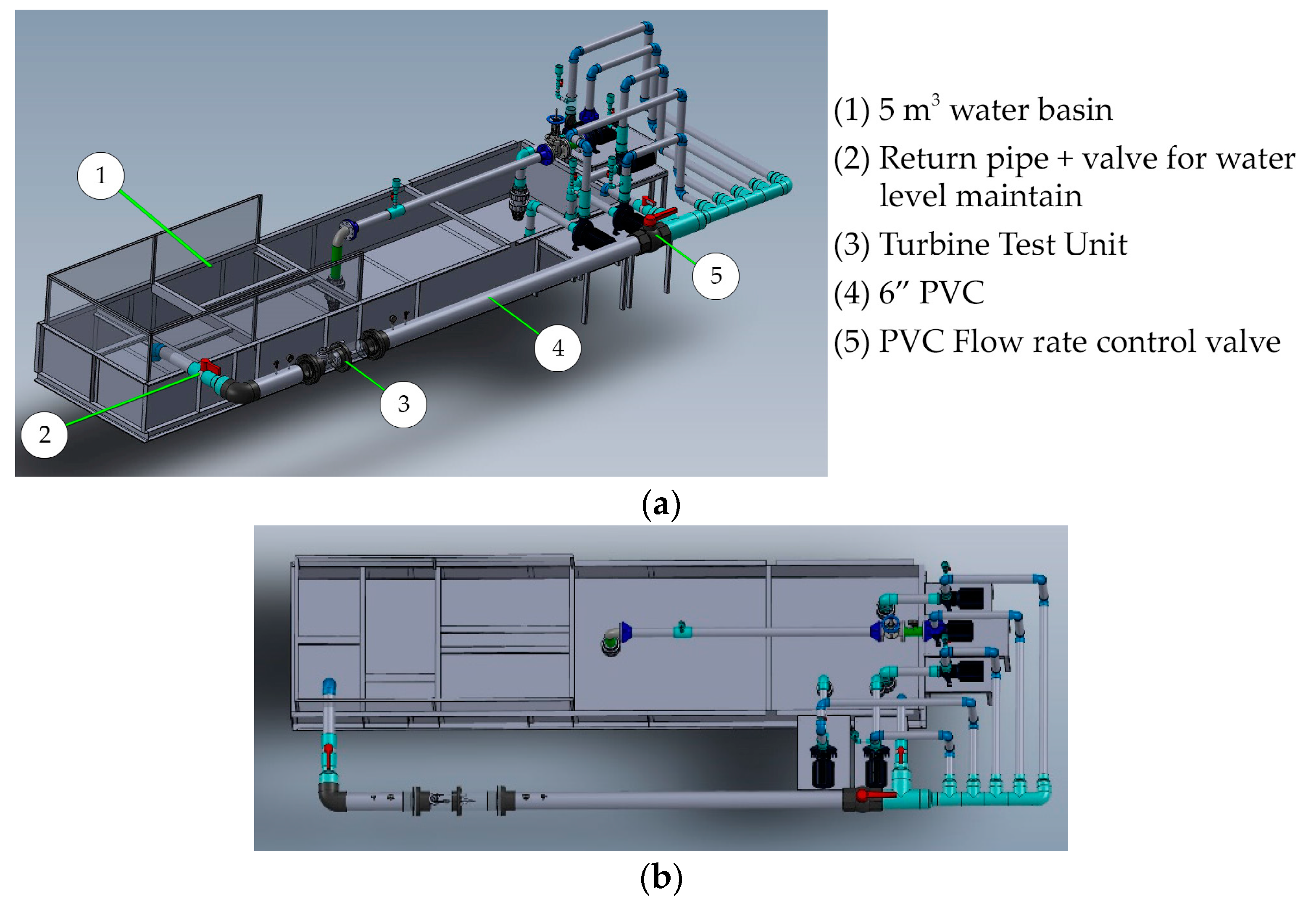
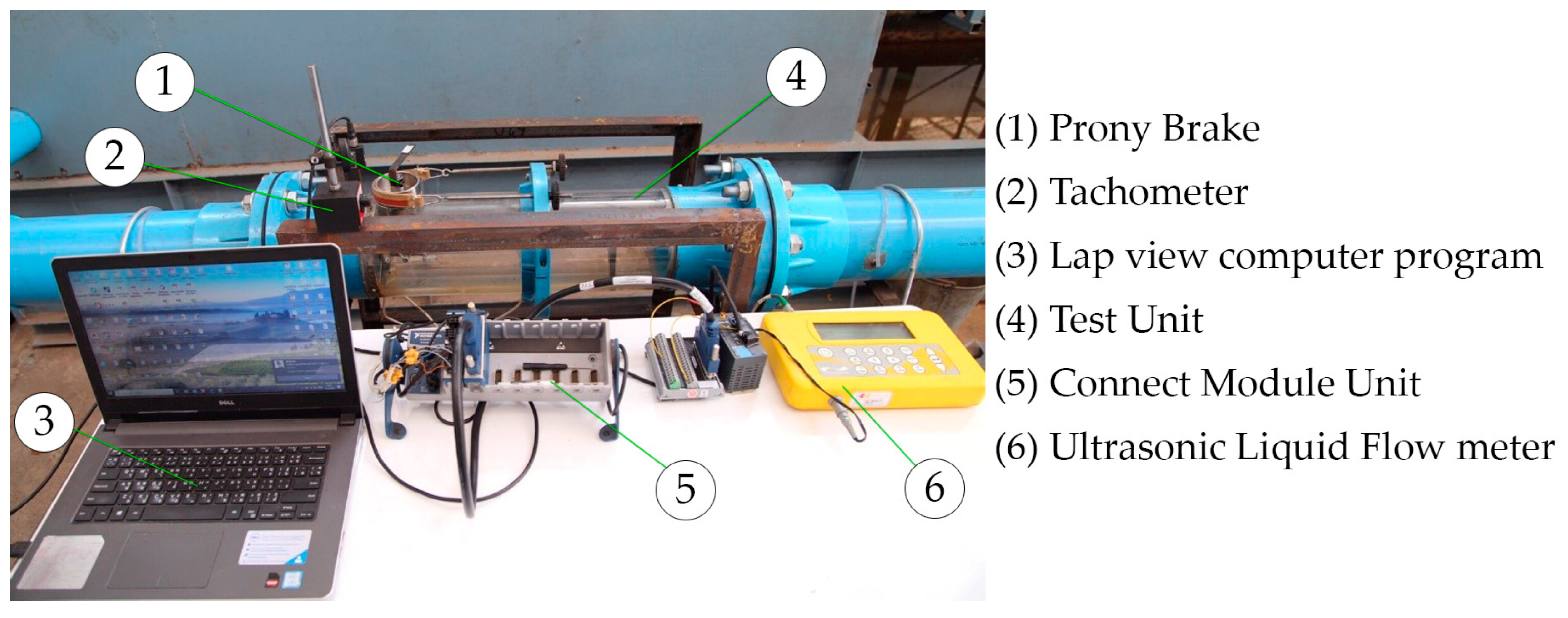
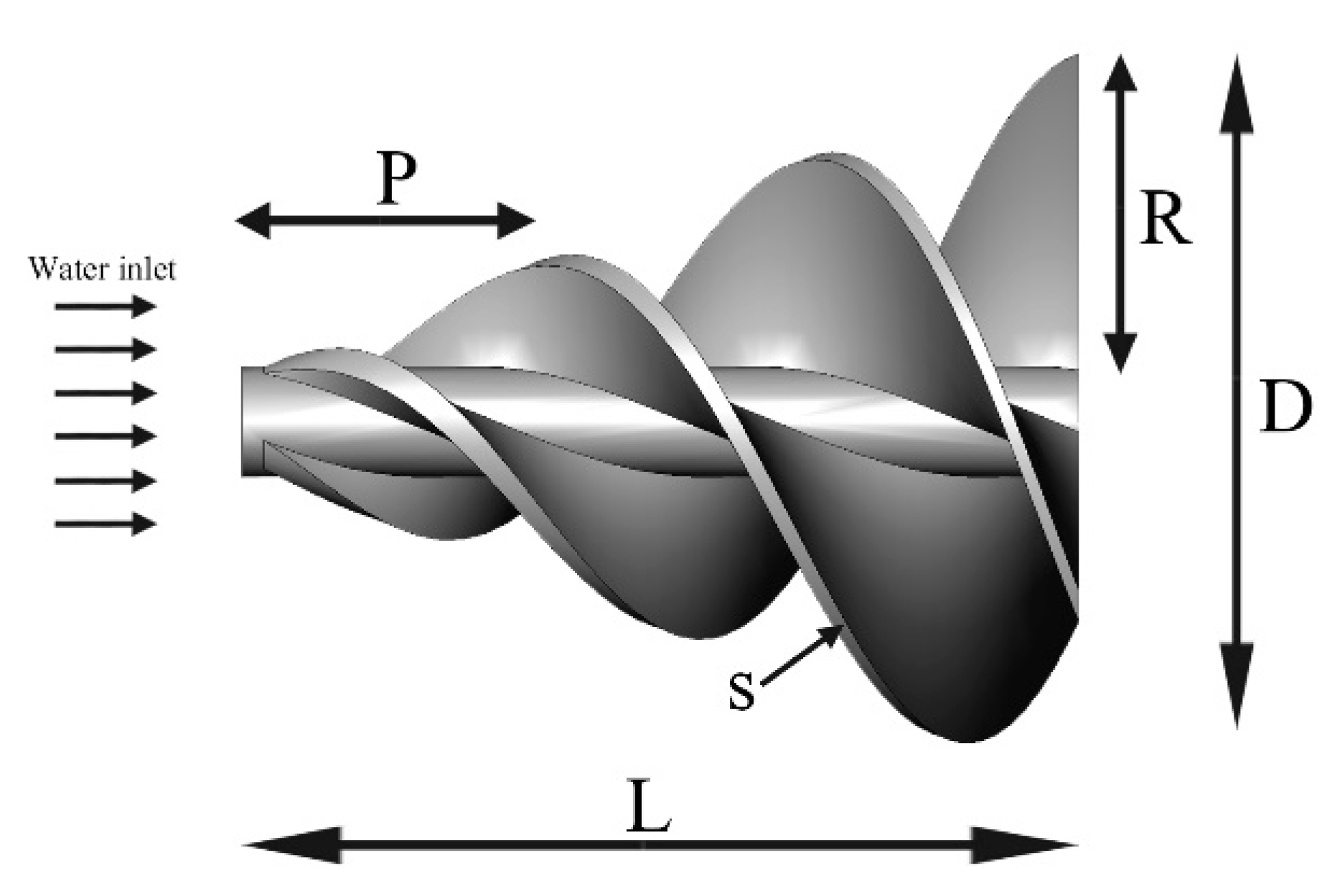

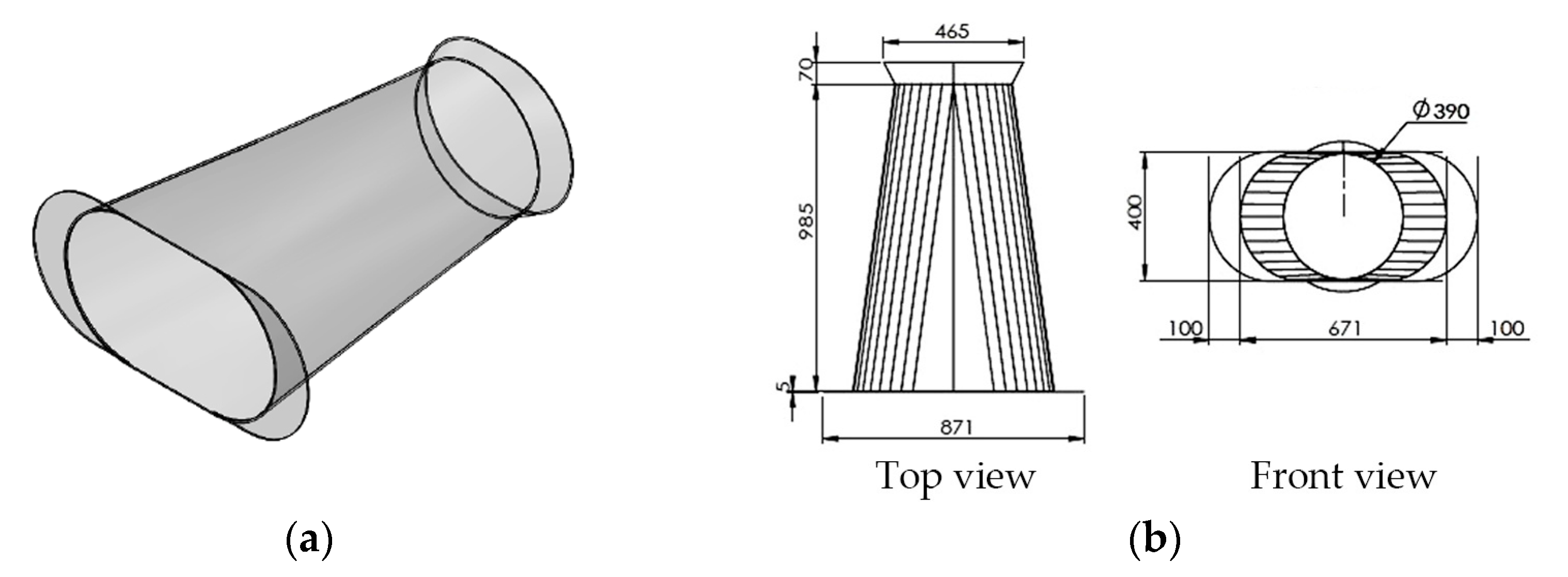
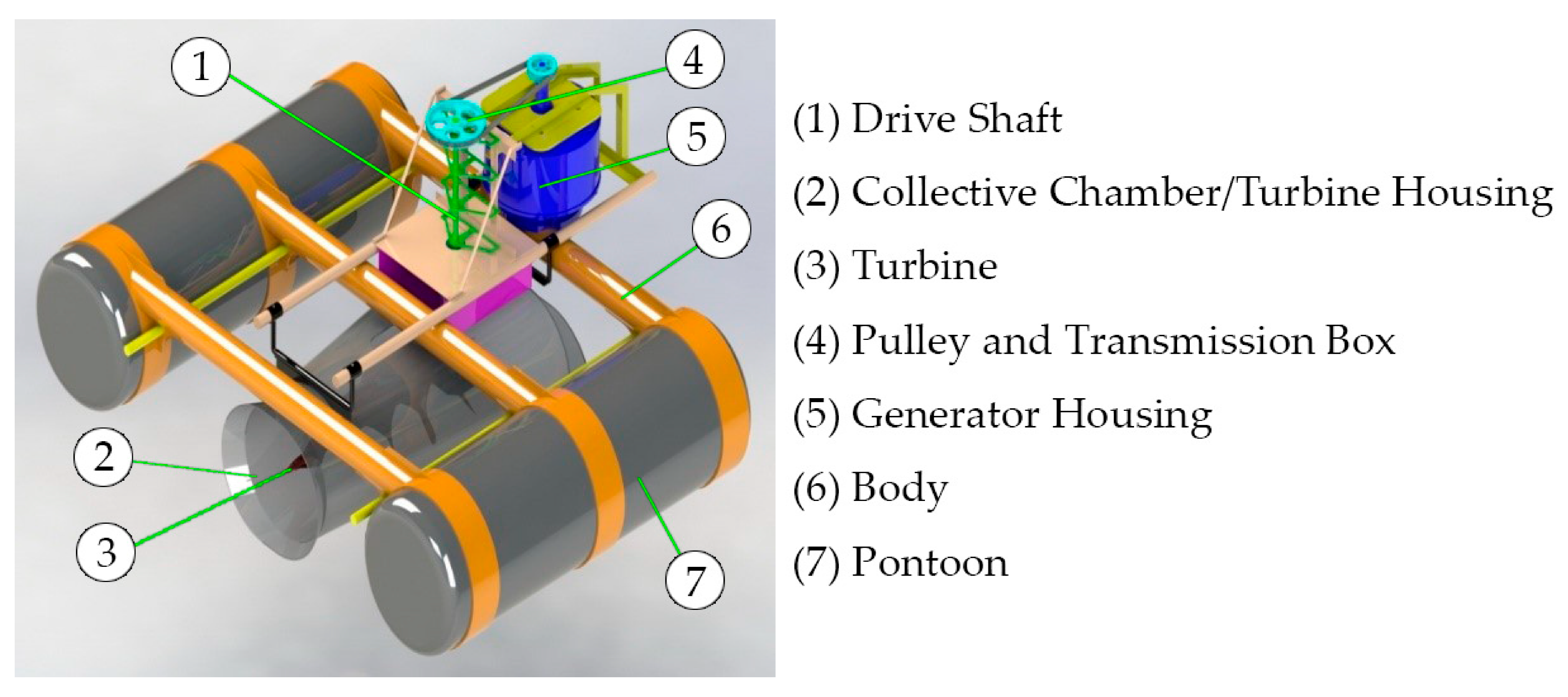
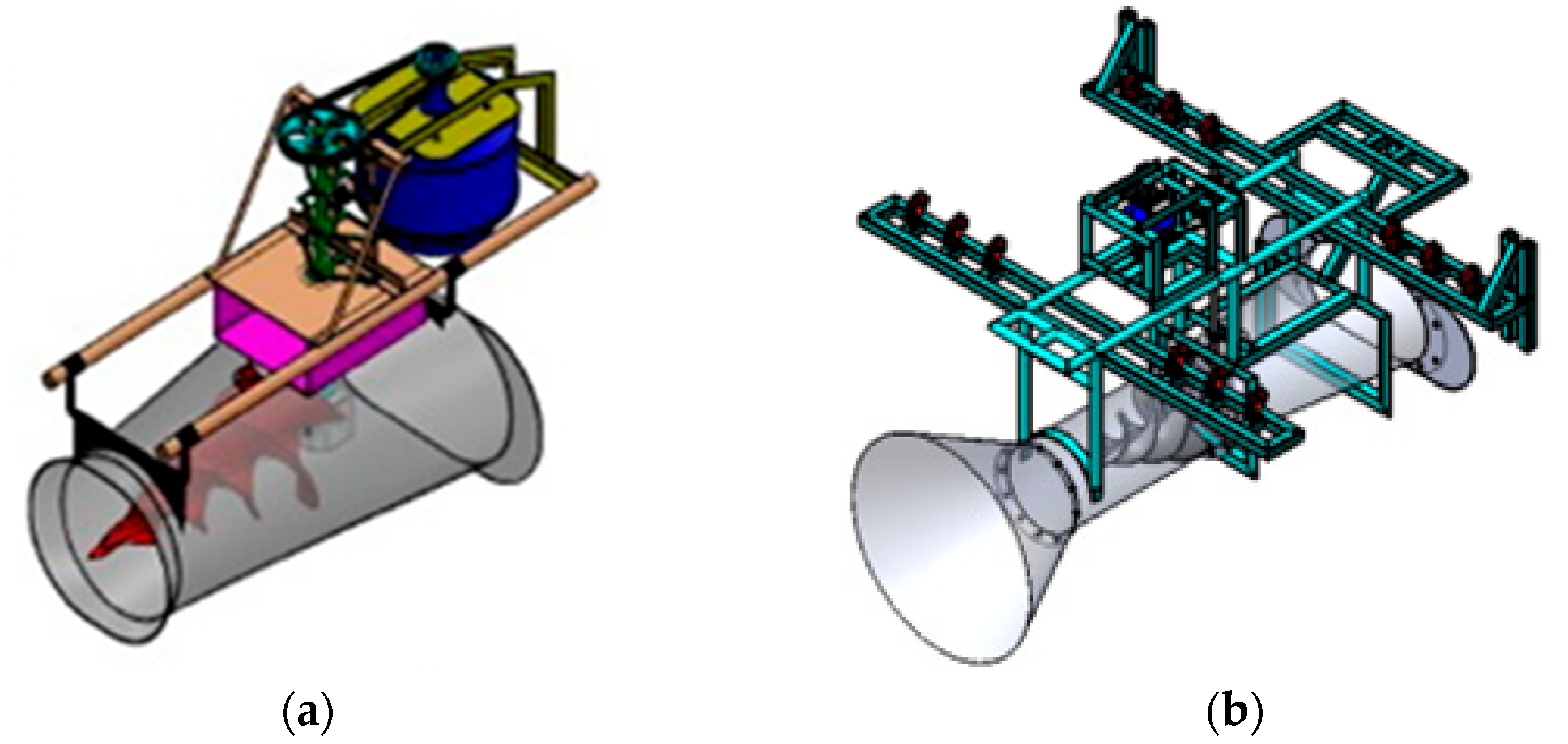
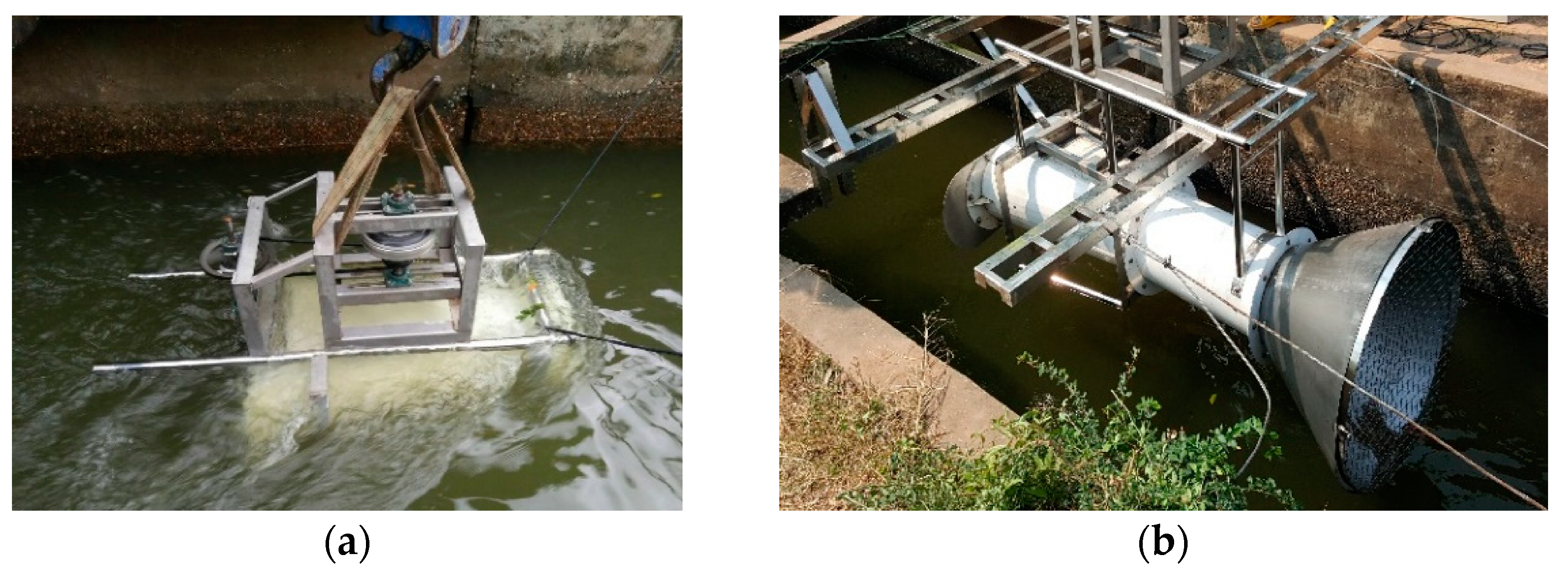
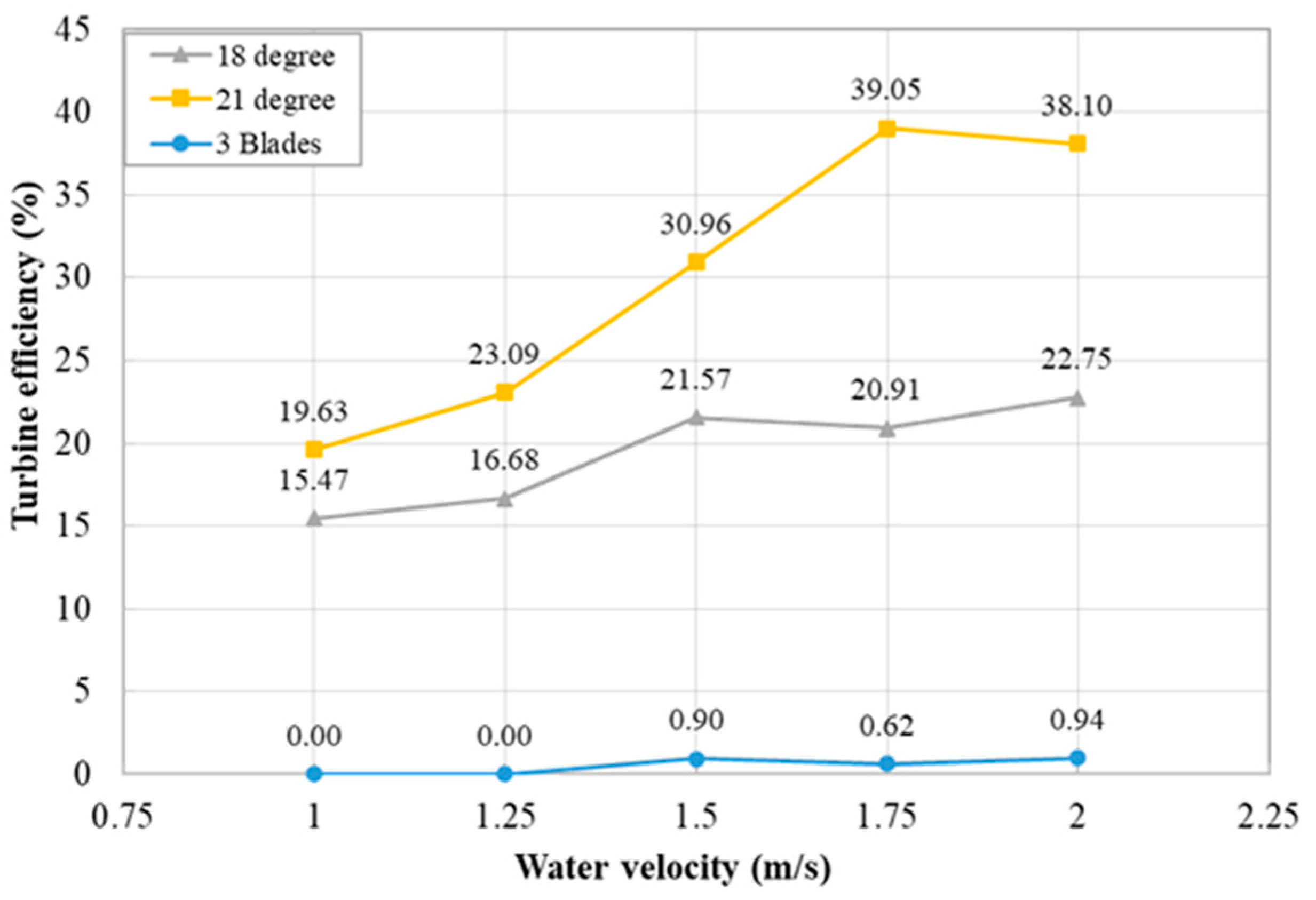
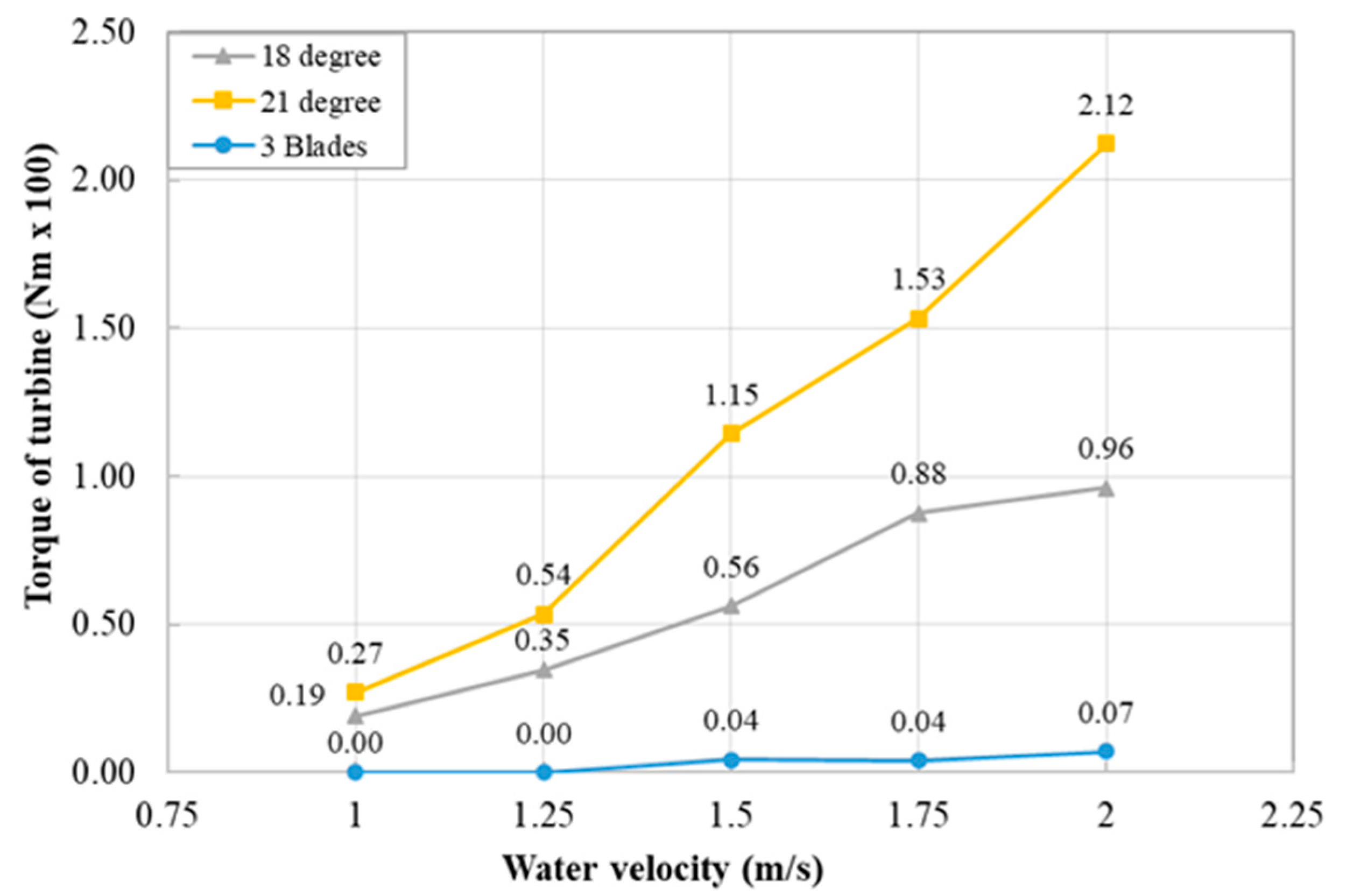

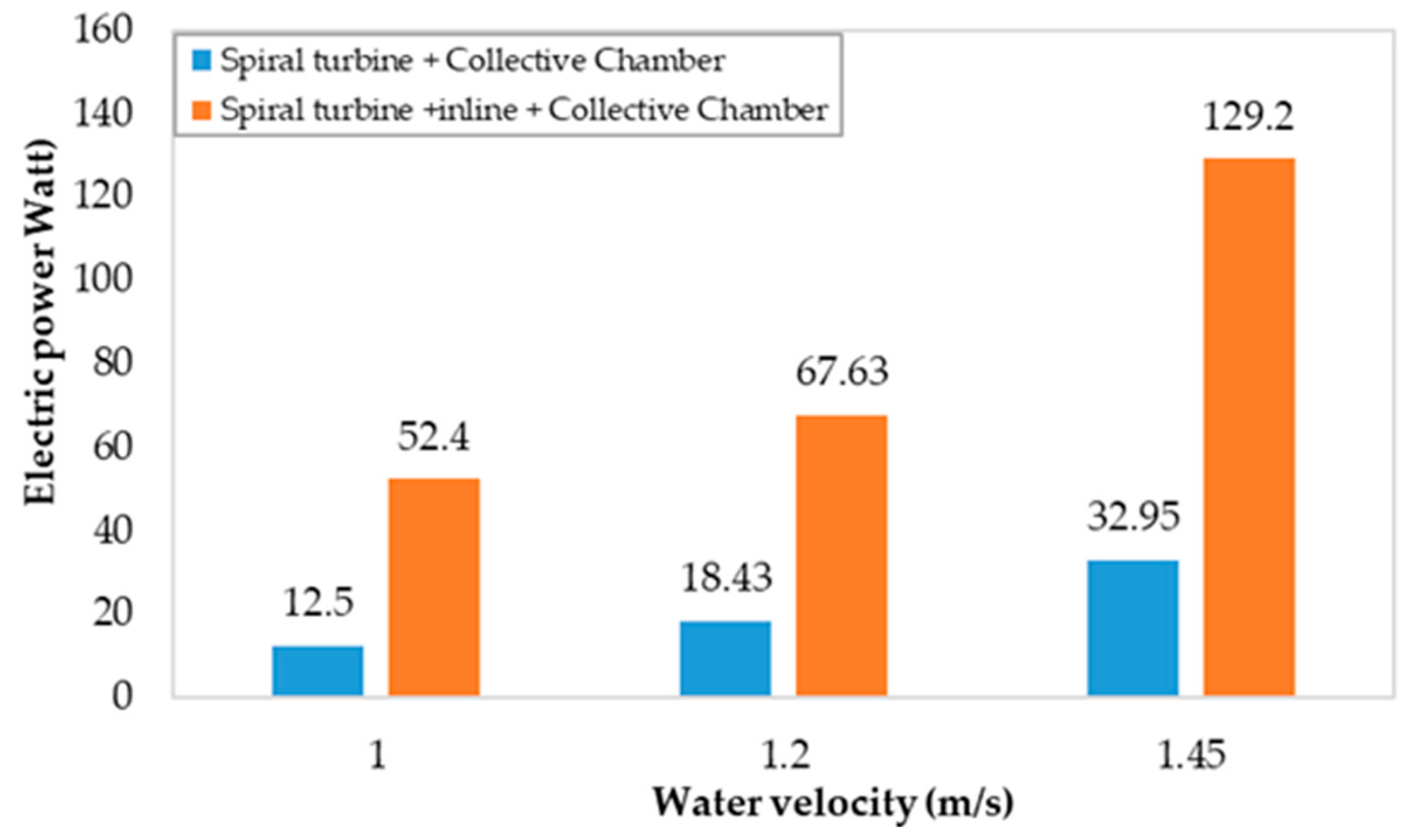
| Manufacturers | Device Name | Turbine Type | Min./Max. Speed | Power Output |
|---|---|---|---|---|
| Lucid Energy Pty., Ltd. (Dallas, TX, USA) [29] | Gorlov Helical turbine | Helical Darrieus cross-axis | (0.6 m/s)/no limit | Up to 20 kW, depends on size |
| Thropton Energy Services (Northumberland, UK) [30,31] | Water current turbine | Axis flow propeller | (0.6 m/s)/depends on diameter | Up to 2 kW at 240 V |
| Tidal EnergyPty., Ltd. (Canberra, Australia) [32] | Davidson–HillVenturi (DHV) Turbine | Cross-flow turbine | Min. 2 m/s | From 4.6 kW |
| Seabell Int.Co., Ltd. (Tokyo, Japan) [33] | Steam | Dual, cross- axis | (0.6 m/s)/no limit | 0.5–10 kW models |
| New Energy Corporation Inc. (Calgary, AB, Canada) [34] | En Current Hydro Turbine | Cross-axis | Max. 3 m/s for maximum power | 5 kW (and 10 kW) |
| Eclectic Energy Ltd. (Nottinghamshire, UK) [35] | DuoGen-3 | Axial flow propeller | Min. (0.93 m/s)/(4.63 m/s) max. | 8 amps at 3.09 m/s |
| Alternative Hydro Solutions Ltd. (Toronto, ON, Canada) [31] | Free-stream Darrieus water turbine | Cross-axis | (0.5 m/s)/depends on diameter | Up to 2–3 kW |
| Energy Alliance Ltd. (Ural region, Russia) [30] | Sub-merged hydro unit | Cross-axis | Min 3 m/s | 1–5 kW (and 410 kW) |
| Turbine | Blade Area (mm2) | Pitch (mm) | Length (mm) | Width (mm) |
|---|---|---|---|---|
| 18-degree | 12,653.72 | 49 | 233 | 150 |
| 21-degree | 10,587.91 | 49 | 197 | 150 |
| 3-blade | 754.96 | - | - | 10 |
| Rated Power | 0.2 kW |
| Rated Rotation Speed | 200 rpm |
| Rated Voltage | 12VAC |
| Efficiency | 90% |
| Start Torque | <0.05 Nm |
| Phase Type | 3 Phase |
| Turbine | Speed of Turbine (rpm) | Torque (Nm × 100) | |
|---|---|---|---|
| Water velocity (m/s) | 1.2 | 1.2 | |
| Spiral turbine + collective chamber | 18-degree | 28 | 13.65 |
| 21-degree | 41 | 21.72 | |
| 3-blade | 26 | 4.56 | |
| Spiral turbine + inline + collective chamber + inlet nozzle 100 cm | 18-degree | 102 | 20.06 |
| 21-degree | 108 | 28.40 | |
| 3-blade | 58 | 7.04 | |
| Turbine | Electric Power (Watt) | |
|---|---|---|
| Water velocity (m/s) | 1.2 | |
| Spiral turbine + collective chamber | 18-degree | 21.90 |
| 21-degree | 28.43 | |
| 3-blade | 6.92 | |
| Spiral turbine + inline + collective chamber + inlet nozzle 100 cm | 18-degree | 26.85 |
| 21-degree | 67.63 | |
| 3- blade | 7.15 | |
| Ref | Turbine | Water Velocity (V) | Section Inlet Area (A) | Work Output (Watt) |
|---|---|---|---|---|
| Wiroon | 21 deg spiral Turbine + diffuser | 1.45 m/s | 0.16 m2 | 67.63 |
| Yasukuni Nishi et al. [41] | 3-blades + diffuser | 1.72 m/s | 0.16 m2 | 154.00 |
| Erinofiardi [54] | Screw Turbine | 0.077 m/s | 0.0088 m2 | 0.28 |
| Tomomi Uchiyama [12] | Guide vane | 0.159 m3/s | 0.005 m2 | 222.00 |
| Joel Titus [55] | Turbine blades | 0.009 m3/s | 0.005 m2 | 212.00 |
| Budiarso [56] | Turgo turbine | n.d. | 0.038 m2 | 5.34 |
| C.H. Achebe [57] | Crossflow turbine | 0.0015 m3/s | 0.015 m2 | 35.00 |
| Gianluce Zitti et al. [49] | Screw turbine | 1-2 m/s | 0.003 m2 | 500.00 |
| Inventory | USD per Unit |
|---|---|
| 429.31 |
| 572.41 |
| 857.67 |
| 572.41 |
Disclaimer/Publisher’s Note: The statements, opinions and data contained in all publications are solely those of the individual author(s) and contributor(s) and not of MDPI and/or the editor(s). MDPI and/or the editor(s) disclaim responsibility for any injury to people or property resulting from any ideas, methods, instructions or products referred to in the content. |
© 2023 by the authors. Licensee MDPI, Basel, Switzerland. This article is an open access article distributed under the terms and conditions of the Creative Commons Attribution (CC BY) license (https://creativecommons.org/licenses/by/4.0/).
Share and Cite
Monatrakul, W.; Senawong, K.; Sritram, P.; Suntivarakorn, R. A Comparison Study of Hydro-Compact Generators with Horizontal Spiral Turbines (HSTs) and a Three-Blade Turbine Used in Irrigation Canals. Energies 2023, 16, 2267. https://doi.org/10.3390/en16052267
Monatrakul W, Senawong K, Sritram P, Suntivarakorn R. A Comparison Study of Hydro-Compact Generators with Horizontal Spiral Turbines (HSTs) and a Three-Blade Turbine Used in Irrigation Canals. Energies. 2023; 16(5):2267. https://doi.org/10.3390/en16052267
Chicago/Turabian StyleMonatrakul, Wiroon, Kritsadang Senawong, Piyawat Sritram, and Ratchaphon Suntivarakorn. 2023. "A Comparison Study of Hydro-Compact Generators with Horizontal Spiral Turbines (HSTs) and a Three-Blade Turbine Used in Irrigation Canals" Energies 16, no. 5: 2267. https://doi.org/10.3390/en16052267
APA StyleMonatrakul, W., Senawong, K., Sritram, P., & Suntivarakorn, R. (2023). A Comparison Study of Hydro-Compact Generators with Horizontal Spiral Turbines (HSTs) and a Three-Blade Turbine Used in Irrigation Canals. Energies, 16(5), 2267. https://doi.org/10.3390/en16052267







